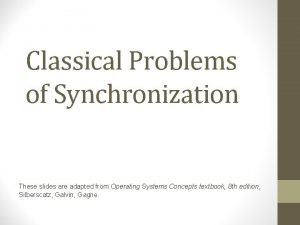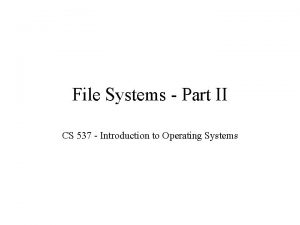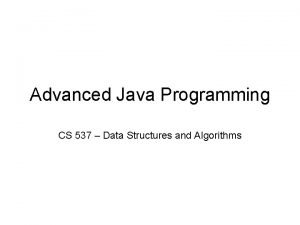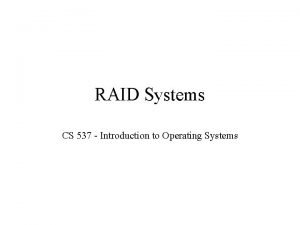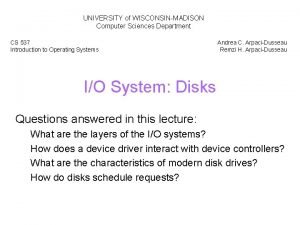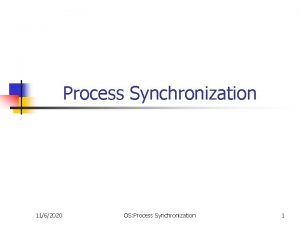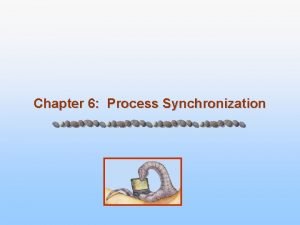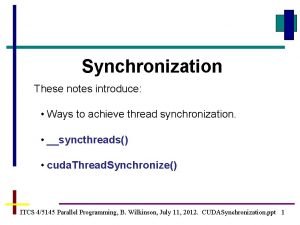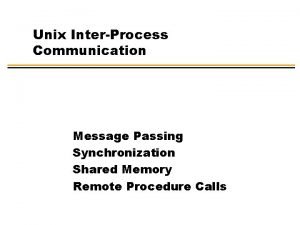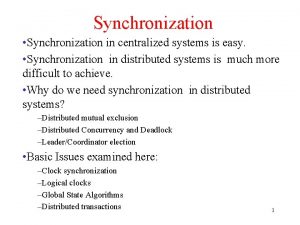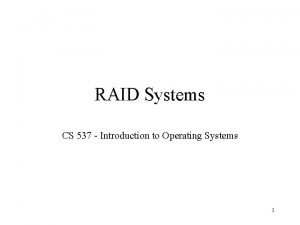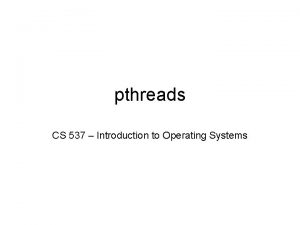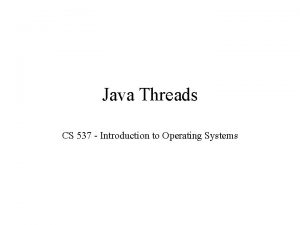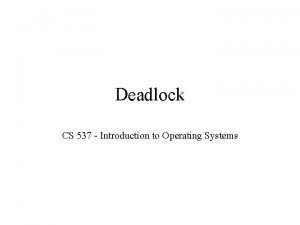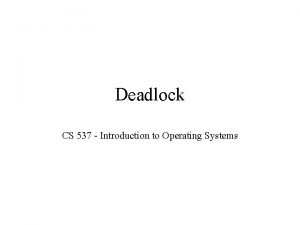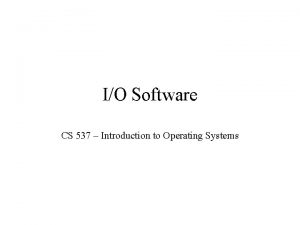Synchronization CS 537 Introduction to Operating Systems What












![Protection Algorithm 2 int flag[2]; // initialize both flag[0] and flag[1] to 0 in Protection Algorithm 2 int flag[2]; // initialize both flag[0] and flag[1] to 0 in](https://slidetodoc.com/presentation_image_h/2162f5fc3c84078ca9c2b5f7411f4abf/image-13.jpg)

![Protection Algorithm 3 int turn; // initialize turn to 0 in main() int flag[2]; Protection Algorithm 3 int turn; // initialize turn to 0 in main() int flag[2];](https://slidetodoc.com/presentation_image_h/2162f5fc3c84078ca9c2b5f7411f4abf/image-15.jpg)















- Slides: 30

Synchronization CS 537 - Introduction to Operating Systems

What is Synchronization? • Recall that there is no guarantee about the ordering of instructions between processes (or threads) • Synchronization is providing explicit control about the ordering of operations

Machine Level Instructions • Single high level language (C, Java, etc. ) are often broken down into multiple machine instructions • Example. . . count ++; . . . ===> ld r 1, [count] add r 1, 1 st [count], r 1 • Interrupt or context switch can occur between any of the above instructions • Most high level instructions are not atomic

Atomocity • Everything happens at once • Machine instructions are atomic – ld r 1, [count] – above instruction can not be broken up by interrupt • High level instructions are not atomic – count++; – this is actually 3 machine level instructions – an interrupt can occur in the “middle” of instr.

Producer-Consumer Revisitted • Let us consider a small section of code Producer Thread Consumer Thread . . . buffer[in] = obj. Produce; count++; . . . obj. Consume = buffer[out]; count--; . . . • Remember that count++ (count--) is actually 3 instructions • One possible interleavening of producer and consumer prod cons ld r 1, [count] ld r 2, [count] add r 1, 1 sub r 2, 1 st [count], r 2 – for above ordering, value of count is 2 • Depending on ordering, could be 2, 3, or 4

Race Condition • Previous example is an example of a “Race Condition” – two threads “race” to place a value in memory – no way to know which one will “win” • Very bad bug – difficult to duplicate because ordering may be different from one run to another – without consistent output, hard to find bugs – producer-consumer example may run fine as long as count stays between 2 and 9

Critical Section • If multiple threads with access to shared data that is writeable, then access to the data by each thread must be controlled • The piece of controlled data for each thread is called its critical section • Banker example – one account for 2 people (Jane and John Doe) – 2 different bank tellers

Banking Example • • • The Doe’s current balance is $1000 (B = $1000) John deposits $100 with teller 1 Jane deposits $100 with teller 2 Teller 1 reads current balance (B = $1000) Teller 2 reads balance (B = $1000) Teller 1 adds John’s deposit to balance (B = $1100) Teller 2 adds Jane’s deposit to balance (B = $1100) $100 dollars was lost Need to control access by tellers to deposits – one teller can’t read balance while another is doing a transaction

Banking Example double balance; void deposit(double amount) { enter. Critical. Section(); balance += amount; leave. Critical. Section(); } int main() { balance = atoi(argv[1]); create. Multiple. Threads(); // creates multiple threads that call deposit wait. For. Threads(); // wait for threads to finish return 0; }

Banking Example • So what are the enter. Critical. Section and leave. Critical. Section functions • Two basic requirements for correctly protecting critical section – mutual exclusion: only one thread in critical section at a time – progress: if no thread in critical section a thread can enter without waiting

Protection Algorithm 1 int turn; // initialized to zero in main() void enter. Critical. Section(int id) { while(turn != id) yield(); } void leave. Critical. Section(int id) { turn = 1 – id; }

Protection Algorithm 1 • Insures mutual exclusion • Does NOT guarantee progress – imagine thread 0’s turn – thread 0 is not in the critical section – thread 1 cannot enter critical section • progress says that it should be able to – worst case scenario, thread 0 ends without ever entering (or leaving) critical section • it will never be thread 1’s turn (thread 1 will never advance any further)
![Protection Algorithm 2 int flag2 initialize both flag0 and flag1 to 0 in Protection Algorithm 2 int flag[2]; // initialize both flag[0] and flag[1] to 0 in](https://slidetodoc.com/presentation_image_h/2162f5fc3c84078ca9c2b5f7411f4abf/image-13.jpg)
Protection Algorithm 2 int flag[2]; // initialize both flag[0] and flag[1] to 0 in main() void enter. Critical. Section(int id) { int other = 1 – id; flag[id] = true; while(flag[other] == true) yield(); } void leave. Critical. Section(int id) { flag[id] = false; }

Protection Algorithm 2 • Again, guarantees mutual exclusion • Does NOT guarantee progress – what if thread 0 sets flag to true and then a context switch – thread 1 sets its flag to true and then blocks in while loop because thread 0’s flag is true – thread 0 will now also block because thread 1’s flag is true
![Protection Algorithm 3 int turn initialize turn to 0 in main int flag2 Protection Algorithm 3 int turn; // initialize turn to 0 in main() int flag[2];](https://slidetodoc.com/presentation_image_h/2162f5fc3c84078ca9c2b5f7411f4abf/image-15.jpg)
Protection Algorithm 3 int turn; // initialize turn to 0 in main() int flag[2]; // initialize both flag[0] and flag[1] to 0 in main() void enter. Critical. Section(int id) { int other = 1 - id; flag[id] = true; turn = other; // give the other guy priority (one thread will win) while ( (flag[other] == true) && (turn == other) ) yield(); } void leave. Critica. Section(int id) { flag[id] = false; }

Protection Algorithm 3 • Combination of algorithm 1 and 2 • Provides both mutual exclusion and progress • Only yeild if BOTH the other thread wants control (its flag is true) and it is the other threads turn • Even if both threads “race” to set the shared turn variable, one of them will win – if both get to while loop at same time, one will go and the other will yield

Semaphores • Previous algorithms do not scale well to more than 2 processes • Another solution - SEMAPHORES! – very simple concept

Semaphores • Each semaphore has a value (S) • Each semaphore has two methods – decrement value (P) – increment value (V) • The P method only returns if S > 0 upon entry to P method • If S 0 upon entry to P, thread blocks until S>0

Semaphores • Example int S; // initialize semaphore to 1 in main() void P() { while(S 0); S--; } void V() { S++; }

Semaphores • For a semaphore to work, P and V methods must be atomic • As written above they are not – we will show to make them atomic later • Notice, P and V do not return any value – simply by returning, they indicate a thread has either obtained or given-up “ownership” of the semaphore

Banking Example Revisited double balance; void deposit(double amount) { P(); balance += amount; V(); } int main() { balance = atoi(argv[1]); create. Multiple. Threads(); // creates multiple threads that call deposit wait. For. Threads(); // wait for threads to finish return 0; }

Using Semaphores • Guarantees both mutual exclusion and progress • There can be many threads running now and using the Semaphore for synchronization – not just 2 threads like previous 3 algorithms • Problem – busy wait • if semaphore not available, the thread “spins” on the value • if single processor, no other thread can do useful work including thread that “holds” the semaphore – solution is for the thread to block instead of spinning

Blocking Semaphores • If S < 0, process adds itself to waiting list • If process sets S to a value greater than zero, it selects a process off of the waiting list (if one exists) and “wakes” it • Waiting list implemented as a linked list – use pointer field in PCB

Blocking Semaphores int S; // initialize S to 1 in main() void P() { S--; if(S < 0) block(); // adds the current process to the waiting list and blocks it } void V() { S++; if(S 0) { W = remove(); // remove some process from waiting list; wakeup(W); // make W runnable - doesn’t necessarily run it next } }

Types of Semaphores • A program can have multiple semaphores – one semaphore for each resource to protect • memory location is a resource • Two type of Semaphores – binary semaphore • semaphore value never greater than 1 – counting semaphore • semaphore value can be any integer over 0 • used if multiple numbers of a given resource – when S = 0, all the resources are used up

Implementing Semaphores • Remember, entire P and V operation must be atomic • Use hardware support to implement – disable interrupts • okay if uniprocessor • won’t work for multiprocessor system – use special hardware instructions • test-and-set • swap

Test-and-Set Instruction • Special, atomic memory operation • Check a single memory location – set a register equal to current value of location – then set the location equal to some set value • Very powerful primitive operation

Test-and-Set Instruction • Assume memory location is either 0 or 1 – return value of 1 means no one currently “holds” this memory location – return value of 0 means another thread currently “has” the memory location – either way, calling thread sets the location to 0 • perfectly legal to set it to zero if it already is zero – calling thread then examines the return value to determine if it can enter the critical section • Operation is atomic - no interrupt during execution of instruction

Test-and-Set Example int S; // initialize to some value int lock; // initialized to 1 void P() { while(test_and_set(lock) != 1); S--; if(S < 0) { add current thread to waiting list; lock = 1; } else { lock = 1; } } void V() { while(test_and_set(lock) != 1); if ( S < 0 ) { wakeup some process waiting on S } S++; lock = 1; }

Swap Instruction • Very similar to test-and-set – swap returns the value currently stored in a memory location – sets the location to a value specified by the user • this is main difference from test-and-set • Used in much the same way – Example of instruction • swap(reg 1, mem. S); • after instruction, mem. S will have original value of reg 1 and reg 1 will have original value of mem. S • Thread checks register for specific value before proceeding
 Classical problems of synchronization in operating system
Classical problems of synchronization in operating system Synchronization tools in os
Synchronization tools in os Synchronization tools in operating system
Synchronization tools in operating system Physical clock synchronization in distributed system
Physical clock synchronization in distributed system Open source operating system
Open source operating system Sda hymn 537
Sda hymn 537 Cs 537
Cs 537 Buddy system memory allocation
Buddy system memory allocation Cs 537
Cs 537 Cs 537
Cs 537 Cs 537
Cs 537 537-317-757
537-317-757 Fast clock to slow clock synchronization
Fast clock to slow clock synchronization Semaphore
Semaphore Process synchronization in os
Process synchronization in os Data synchronization in tally erp 9
Data synchronization in tally erp 9 Multiprocessor synchronization
Multiprocessor synchronization What is lean synchronization
What is lean synchronization Show bgp neighbor
Show bgp neighbor Lock free synchronization
Lock free synchronization Process synchronization in os
Process synchronization in os Basic synchronization principles
Basic synchronization principles Windchill commonspace
Windchill commonspace Cuda critical section
Cuda critical section Process synchronization definition
Process synchronization definition Laser synchronization
Laser synchronization Pthread synchronization
Pthread synchronization Posix shared memory synchronization
Posix shared memory synchronization Synchronization primitives c#
Synchronization primitives c# Synchronization algorithms and concurrent programming
Synchronization algorithms and concurrent programming Process synchronization definition
Process synchronization definition
